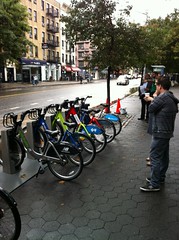Last night at a meeting of Community Board 3’s Transportation and Public Safety Committee, the director of the Department of Transportation’s bike share program presented a comprehensive overview of a plan to bring 10,000 bikes to a total of 600 stations across the city.
Kate Fillin-Yeh said the city carefully examined existing bike share programs in the United States, London, and Paris before selecting Alta Bicycle Share — which operates bikes in Washington, D.C. and Boston — to spearhead the New York operation, which may be the first to debut an option that does not require credit cards.
As The Local mentioned when the program was previewed at Tompkins Square Park, annual passes will be offered for around $100, less than a monthly MetroCard. Day passes will cost between $8 and $10 dollars, and there may be a weekly option as well. The first thirty to forty-five minutes of each trip is included in the price, but a small fee will be charged for each additional hour.
The city has already approved a high volume of solar-powered, WiFi-enabled stations serving 1.2 million residents from the Upper East and West Sides down into lower Manhattan and Brooklyn. Satellite stations may be available in parts of the Bronx and Queens. In a given area, stations will be placed every three to four blocks, as well as on most avenue corners. Residents will be able to recommend locations at community-planning workshops, said Ms. Ms. Fillin-Yeh.
Board member Chiun Ng believed the program could be a boon to the neighborhood. “If you look at the map, portions of the East Village are underserved by the subway system,” he said. “In rush hour the bus is packed, especially as you get near the big housing project.”
An architect and avid cyclist himself, Mr. Ng questioned Ms. Fellin-Yeh about coverage in the East Village and Lower East Side’s lower income areas. “Income levels will be diverse,” he noted, “and the cultural background is very diverse.” He said affordable pricing and outreach efforts would be crucial.
Several residents, as well as a representative from local advocacy group Transportation Alternatives, attended the meeting in support of the program.
East Village resident Martin Brown, 52, expressed the hope that it might do something to civilize the culture of biking. “It may no longer be dominated by those who bike through red lights and terrorize pedestrians,” Mr. Brown said.
Bicycle helmet in hand, Betty Cremmins, 26, agreed. “There are very few causes I strongly support — but this is one,” she said. “If you ever try to go towards the east side, [subway service] gets very sparse. I ride to work, I ride for errands, I ride all over. I’m very excited about this.”
Ms. Cremmins, who was born in the East Village and now lives on Fourth Street, mentioned safety as an added benefit of the program. The Department of Transportation’s own statistics have shown that the Lower East Side is one of the most dangerous neighborhoods for cyclists. The East Village includes a corner once infamously dubbed “dead man’s curve.”
“The more bikes there are on the road, the safer it gets for everyone,” Ms. Cremmins said. “With critical mass comes safety in numbers. We feel more of a presence on the road, and it’s a traffic calmer as well.”
According to Ms. Fellin-Yeh, bike-share bicycles are also heavy, weighing about 40 pounds each, and therefore “not built for speed; built for civility.”




